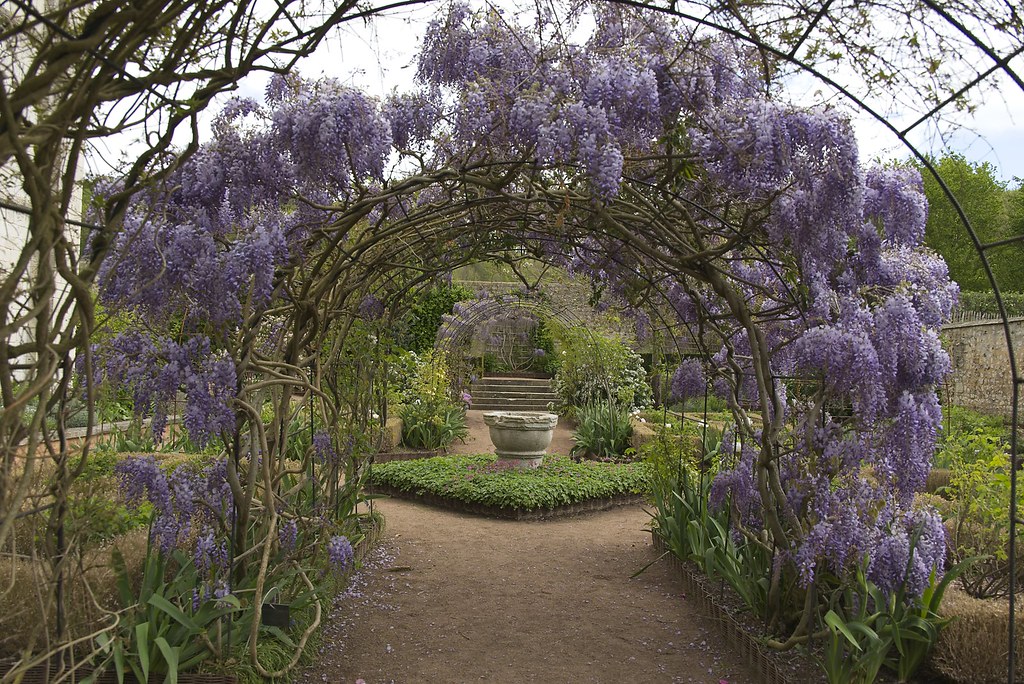Green thumbs and floral enthusiasts! If you’re dreaming of transforming your garden into an enchanting oasis with native wisteria arches, you’re in luck. With the right variety and a bit of care, you can create a living floral masterpiece that will rival the Bridgerton estate. Let’s dive into the world of wisteria and learn how to bring this vision to life in North Carolina’s zone 7b or similar climates.
Choosing the Right Wisteria
Imagine your garden draped in stunning purple flowers, much like the Bridgerton family’s mansion. To achieve this, it’s crucial to pick the right variety of wisteria. Not all wisterias play nice—some can grow too aggressively and take over your garden. The best choice is Wisteria frutescens, also known as American wisteria. This southeastern U.S. native thrives in Zones 5-9 and can reach impressive heights of up to 30 feet. It’s known for its manageable growth and breathtaking clusters of flowers.
American Wisteria (Wisteria frutescens)
Variety: ‘Amethyst Falls’
Bloom Time: May and sometimes again in the summer
Growth: Up to 30 feet, twining counterclockwise
Climate: Hardy in Zones 5-9
For those in cooler climates, consider Kentucky wisteria (Wisteria macrostachya). It blooms in June and can offer up to three rounds of flowers per season.
Kentucky Wisteria (Wisteria macrostachya)
Variety: ‘Blue Moon’
Bloom Time: June
Growth: More winter-hardy, with fragrant flower clusters
Planting and Caring for Wisteria
Ideal Location and Structure
Wisteria loves the sun, so choose a spot with at least six hours of direct sunlight daily. Well-drained, moist soil is ideal. If your soil isn’t perfect, amend it with organic matter to improve drainage and fertility.

A strong support system is essential. Whether you opt for a wooden arbor or a metal arch, ensure it’s sturdy enough to handle the weight of mature vines. Use weather-resistant materials and secure your structure with concrete footings.
Planting Steps
1. Timing: Plant in spring or fall for the best results.
2. Hole Preparation: Dig a hole as deep as the root ball and two to three times as wide.
3. Spacing: Space your plants 10 to 15 feet apart for archways.
4. Watering and Mulching: Water thoroughly after planting and apply a layer of mulch to retain moisture and suppress weeds.
Training and Pruning
Guide the young vines onto the arches with soft ties, encouraging them to twine around and create an intertwined look. Pruning is crucial for healthy growth and abundant blooms.
1. Winter Pruning: Cut back the previous season’s growth to a few inches, leaving buds for new blooms.
2. Summer Pruning: After the flowers fade, trim back the long shoots to about 6 inches from the main branches to promote more blooms for the next season.
Avoiding Invasive Wisterias
Be cautious with Wisteria sinensis and Wisteria floribunda from China and Japan. These varieties can grow up to 70 feet and are known for their aggressive growth, which can smother other plants and even damage structures. Stick to native varieties like American and Kentucky wisteria to avoid these issues.
Troubleshooting and Blooming Tips
If your wisteria isn’t blooming, ensure it’s getting enough sunlight—at least six hours a day. Protect it from late frosts and high winds, which can damage flower buds. Avoid high-nitrogen fertilizers, as they can lead to excessive foliage growth at the expense of blooms.
Creating a Floral Masterpiece
With the right care and patience, your native wisteria arches will become a stunning display of floral artistry. It may take a few years for a new plant to start blooming, but the wait is worth it. Enjoy the process of nurturing and shaping your living masterpiece, and when those first blooms arrive, bask in their beauty and fragrance.
Transform your garden into a regal oasis with native wisteria arches. Choose the right variety, provide plenty of sunlight, and keep up with your pruning, and you’ll have an enchanting garden feature that will be the envy of the neighborhood. Happy gardening!
Related posts:
Grow a Wisteria Archway with These Types That Won’t Take Over
How to Grow Wisteria Vines
Pruning and Training Wisteria





